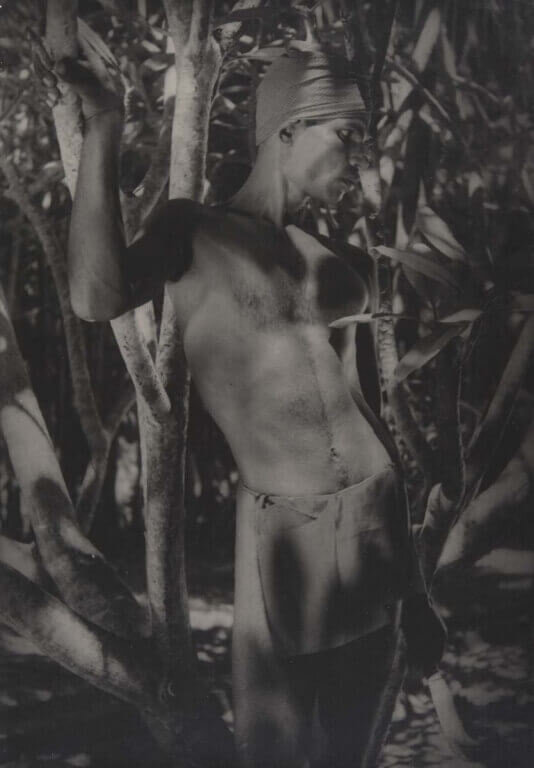Lionel Wendt, a Pioneer Photographer Who Showcased Ceylonese Cultural Identity
Lionel Wendt, “Ennui,” from Pinterest.
When Derek and I were planning the aesthetics of the Parampara brand, he was inspired by Lionel Wendt's black and white portraits. They are powerful images with dramatic lighting that immortalize the human form, making the subjects appear statuesque, reminiscent of Rodin's The Thinker. The contrasting lighting also draws the viewer's attention to the various focal points of the subjects, thereby removing their identity but creating a persona—the persona of the working-class men of Ceylon.
Lionel Wendt was an enigmatic character who was a driving force in Sri Lanka's avant-garde scene in the 1930s and 1940s. Born in 1900 in Colombo, Ceylon (became Sri Lanka after its independence from Britain in 1948), Wendt came from an influential Dutch Burgher family. He was trained as a lawyer but practiced as a concert pianist, critic, and photographer. Even after his untimely death in 1944, at age 44, the art collective he spear-headed, '43 Group, continued to thrive. Wendt and his fellow artists wanted to elevate a new style built on modernist trends overseas that also drew on Ceylonese landscape and culture.
Portrait of Lionel Wendt, from Wikipedia.
Wendt came of age when there were significant political, social, and cultural shifts in Ceylon. The colony’s intelligentsia class, consisting of artists, academics, and other cultural creators, pursued new strategies for defining the nation for themselves as it moved closer towards independence. Wendt's photographs of Ceylonese subjects, landscapes, and culture form a part of the core artistic production that challenged imperial rule. By tapping into Ceylonese values that had become marginalized under western domination and expressing them in modernist techniques, Wendt and his contemporaries shed their culture in a new light.
Wendt didn't discover his passion for photography until the 1930s and devoted the latter part of his life to the art form. He was noted for his homoerotic, black and white portraits of young men, many of whom came from the labouring class, men outside of his own privileged Dutch Burgher background. On his subjects, Wendt applied generous amounts of coconut oil. Under Wednt’s contrasting lights, their skin shone with stunning, spectral quality. Wendt also experimented with various techniques, including wide-angle and telephoto lenses, brom-etching, and solarization. The results were a refreshing perspective on Ceylonese culture that helped formulate the identity of a nation.
Lionel Wednt’s Young Man with Fishing Net, 1935, from AnOther.
A photograph in which Wendt used the solarization technique, from Art Crime Archive.
Derek was inspired by Wendt's interpretations of Ceylonese cultural tradition and believed that it could complement Parampara's value and aesthetics. Derek paid homage to Wendt's work by borrowing his techniques to apply to our photo styling. Unlike many examples of portrait photography, in which the subject's face is the focal point of the image, Wendt blurred his subjects' faces with contrasting lighting and obscured their eyes. The results evoked mesmerizing sensuality and mystery. Derek particularly loved that Wendt's lack of a central focus point to hold the gaze and the body could be used as a backdrop to showcase jewellery. We asked two of our Sri Lanka friends, Liza and Thanu, to be our models. We oiled them up and posed them before contrasting lighting, banana leaves and other leafy branches we found near Mount Lavinia beach.
Model: Liza Nadine Onella; Photographer: Derek Matthew Auxier Black; Stylist: Rebecca Russell-Turner; Photography Assistants: Lewis Bower and Kayo Chang Black
Model: Thanu Jayawardene; Photographer: Derek Matthew Auxier Black; Stylist: Rebecca Russell-Turner; Photography Assistant: Kayo Chang Black
There is no denying that Wendt's male nudes reflected his sexual inclination—the viewer's eyes are fixated on the sensual aspects of the subjects, namely their lips and muscular bodies. However, Wendt's sexual orientation was never discussed. Homosexuality was illegal in Ceylon, and it remains so in Sri Lanka to this day. Wendt had a life-long friendship with fellow artist George Keyt, who he met as a boy. However, the true nature of their relationship, to this day, is only for speculation.
Soon after Wendt's death, the executioner of his will had all his negatives destroyed on the ground that photographers preferred to develop their own work. According to this person, it was standard procedure to dispose of negatives when a photographer passed away. Sadly, all that remains of Wendt's extensive body of work are prints scattered throughout various private collections and museums.







